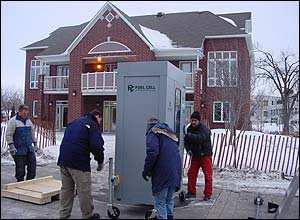Fuel Cell in the Minto 'Phantom' house

It's actually a fully automated research house built on the Ottawa campus of the National Research Council (NRC) to study various energy conservation and environmental technologies and materials for new-home construction.
It just happens to be occupied by a phantom family of two adults and two children.
It was also the first home in Canada to get its heat and electricity from a fuel cell. The home was even able to feed its excess electricity back into the city's electrical grid.
Twin homes were built on the NRC campus in 1998 by Minto Developments Inc. and nobody lives in either.
One house keeps getting new technology. The other is called the reference house and remains as it was built, so researchers can measure the differences.
The Canadian Centre for Housing Technology is a $1.5-million facility that comprises the twin homes and the CCHT InfoCentre, built by Minto in 1999.
The centre is a joint venture by three government agencies: the NRC, Canada Mortgage and Housing Corp. and Natural Resources Canada, according to research manager Mike Swinton, who also works as a researcher at the NRC.
A computer in the research house runs a teenager's shower for 15 minutes a day. It doesn't pound on the bathroom door, but merely shuts the water off. It allows two traditional showers a day, lasting five minutes each. And the computer fills the bathtub once a day with hot water. Researchers have decided the phantom family will share the bath water.
The lights stay on all night in the bedrooms because researchers use 60-watt light bulbs in various rooms to simulate the heat given off by an adult body. Each child produces heat equivalent to a 40-watt bulb. When the lights are on in the bedrooms all night, it means they're sleeping.
Even the family dog is represented, but that lonely light lives in the basement.
Swinton says the dog light also serves as a safety feature for researchers, who head down into the windowless basement to read meters.
Many companies test their new ideas in technology and materials for building in the experimental home before deciding if it is ready for the open market.
Fuel Cell Technologies Ltd. of Kingston installed a fuel cell in the test house last March for a three-month experiment.
Vikram Varma, director of corporate development at the Kingston firm, is not permitted to fully disclose the results of the experiment, but admits, "We are very happy with the results we got. They were beyond what we anticipated."
He notes there are no homes operating in Canada today with a fuel cell, which uses hydrogen and oxygen as fuel.
The chemical reaction of combining oxygen and hydrogen produces electricity and heat, and the exhaust is merely water.
Swinton says the fuel cell in the Ottawa test house produced spatial heat, hot water and electricity for the home, and also dumped excess electricity into the city's grid system.
Varma says the firm will conduct further testing of its residential fuel cell at the Hydrogen Village on Mississauga's Erindale campus of the University of Toronto.
The village is a joint venture of academia, business and government, designed to accelerate the commercialization of hydrogen fuel cells.
Each test house in Ottawa has more than seven kilometres of wiring and is crammed full of monitoring devices.
The two-storey twin homes are fully bricked and are 2,100 square feet in size, with four bedrooms and an attached two-car garage.
Swinton says Minto built many of the same model, called the Sierra, at one of its housing projects on Ottawa's east side.
"One of our researchers liked the test house so much that he went out and bought the same house from Minto on the east side," he says.
Swinton notes heating, cooling and ventilating technology are the most studied procedures in the test home. Windows are changed regularly, as manufacturers produce new window technology and designs to be tested.
He says a variety of new technologies to reduce energy use are being tested, but he can't be more specific because confidentiality is another big part of the government/business relationship in the studies.
A Japanese firm is currently testing a geothermal ventilation system it installed in the house. The device draws outside air into an underground tube, which heats or cools the air, depending on the season, before it goes into the house.
Water in the tube cleans impurities from the air.
The phantom family also play host to visitors from throughout Europe and Asia, who come to study Canada's world-leading house construction and design techniques.
Swinton says the test house welcomes an average of one delegation a week.


0 Comments:
Post a Comment
<< Home